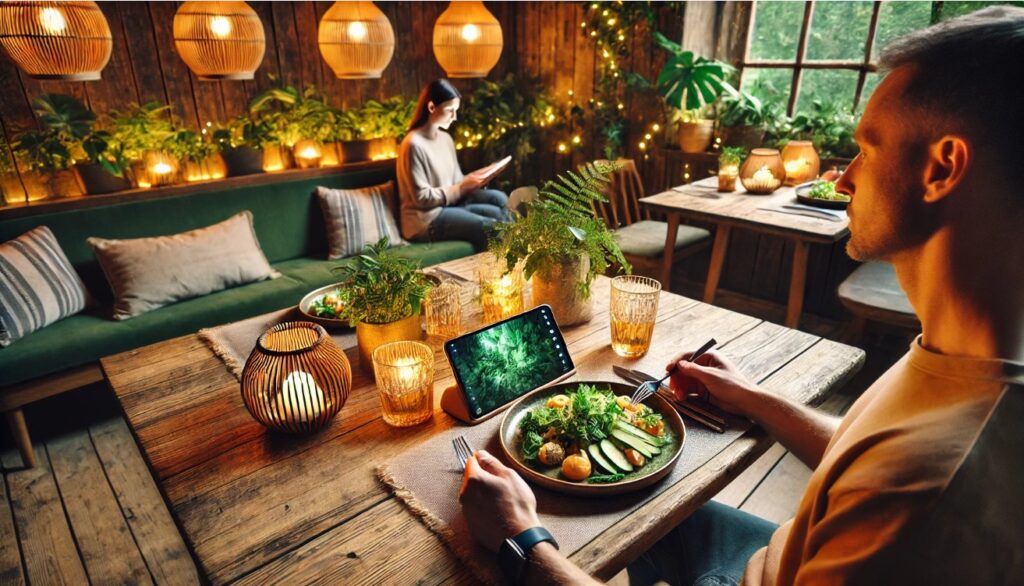Digital Detox Diets: A 2025 Food Trend

How Mindful Eating is Tied to Reduced Tech Dependency
The world is more connected than ever, with screens competing for our attention from the moment we wake up to the moment we sleep. While technology has transformed the way we work, communicate, and even eat, its overuse has led to growing concerns about mental health, stress, and digital dependency.
One response to this issue is the Digital Detox Diet—a growing food trend in 2025 that encourages people to unplug from screens while eating, fostering mindful eating habits and improving overall well-being. This movement aligns with the increasing emphasis on health trends, wellness, and mental clarity, making it one of the most talked-about lifestyle changes of the year.
What is a Digital Detox Diet?
The Digital Detox Diet is not about restricting food groups or following calorie counts; instead, it’s about changing how we engage with food. The key principles include:
✔️ Eating without digital distractions – No phones, tablets, TVs, or laptops during meals.
✔️ Practicing mindful eating – Slowing down, appreciating food, and engaging all the senses.
✔️ Being present – Enjoying conversations, reflecting on flavors, and recognizing hunger cues.
✔️ Reducing stress – Creating a relaxing mealtime environment.
This approach promotes a stronger connection with food, improved digestion, and healthier eating habits.
The Science Behind Mindful Eating
The Digital Detox Diet is rooted in the principles of mindful eating, a practice supported by numerous studies in nutrition and psychology. When people eat while watching screens, they tend to:
📌 Overeat – When distracted, the brain doesn’t register fullness as effectively, leading to excessive food intake.
📌 Make poorer food choices – Mindless snacking and fast-food consumption increase when we eat while multitasking.
📌 Experience digestive issues – Rapid eating and lack of focus can contribute to bloating and poor digestion.
On the other hand, mindful eating has been shown to:
🟢 Improve digestion and gut health
🟢 Reduce emotional eating and binge eating tendencies
🟢 Help with weight management
🟢 Enhance enjoyment and satisfaction with food
Why This Trend is Gaining Popularity in 2025
The Digital Detox Diet is part of a larger movement toward holistic well-being, where people seek to balance physical, mental, and emotional health. Several factors are driving its popularity:
📱 1. The Rise of Tech Fatigue
With remote work, social media, and 24/7 digital connectivity, many people feel overwhelmed by screen time. Reducing tech usage during meals provides a simple way to reclaim control over personal time and reduce stress.
🍽 2. Growing Awareness of Mindful Eating
Nutritionists and wellness experts are increasingly advocating for mindful eating as a way to improve digestion, manage weight, and build a healthier relationship with food. This approach aligns well with the digital detox concept.
🧘♂️ 3. Connection to Mental Wellness
Excessive digital consumption has been linked to anxiety, poor sleep, and reduced focus. The Digital Detox Diet encourages people to take small steps toward a calmer, more mindful lifestyle.
👨👩👧 4. The Desire for More Meaningful Social Interactions
Eating together without distractions fosters deeper connections between family members, friends, and even colleagues. The slow food movement and the return of family dinners are making a comeback, emphasizing the importance of tech-free meals.
How to Incorporate the Digital Detox Diet Into Your Life
If you want to try a Digital Detox Diet, here are some easy ways to get started:
Step 1: Set a “No Screens at the Table” Rule
🔹 Keep phones, tablets, and laptops away during meals.
🔹 Use a tech-free dining space where screens are not allowed.
Step 2: Engage Your Senses While Eating
🔹 Notice the colors, textures, and aromas of your food.
🔹 Take smaller bites and chew slowly.
🔹 Appreciate the flavors instead of eating on autopilot.
Step 3: Make Meals Social & Interactive
🔹 Eat with family or friends, engaging in conversation instead of scrolling.
🔹 If eating alone, focus on your meal instead of watching videos or reading emails.
Step 4: Practice Gratitude & Reflection
🔹 Before eating, take a moment to acknowledge your food—where it came from and how it nourishes your body.
🔹 Reflect on how you feel after a tech-free meal—more satisfied? Less rushed?
Digital Detox Diet in Action: A Sample Daily Plan
Here’s what a tech-free eating routine might look like:
☀️ Morning: Mindful Breakfast
❌ No checking emails or scrolling through social media.
✅ Enjoy a nutritious breakfast, focusing on flavors and textures.
🍽 Lunch: A Tech-Free Break
❌ Avoid eating in front of a laptop or watching YouTube.
✅ Step away from work and eat in a calm environment.
🌙 Dinner: A Relaxing, Screen-Free Meal
❌ No TV or phone at the table.
✅ Engage in meaningful conversations or reflect on the day.
The Bigger Picture: More Than Just Food
The Digital Detox Diet is about more than just eating—it’s about reclaiming presence and mindfulness in daily life. By reducing screen time and practicing mindful consumption, people can experience:
✨ Better digestion and overall health
✨ More meaningful social interactions
✨ Reduced stress and improved mental clarity
✨ Greater appreciation for food and eating rituals
As we move forward in 2025, this trend isn’t just about what’s on your plate—it’s about how you experience it.
Final Thoughts: Is the Digital Detox Diet Right for You?
If you’ve ever felt disconnected from your meals, overwhelmed by screen time, or simply want a healthier approach to eating, the Digital Detox Diet might be worth a try. With small, intentional changes, you can transform mealtime into a more mindful, satisfying, and nourishing experience.
Would you be willing to try this tech-free eating trend? Let us know in the comments! ⬇️💬
